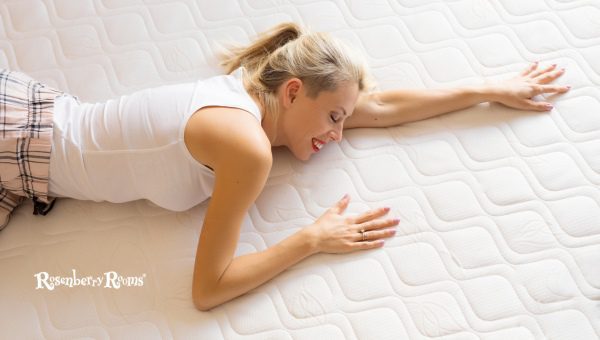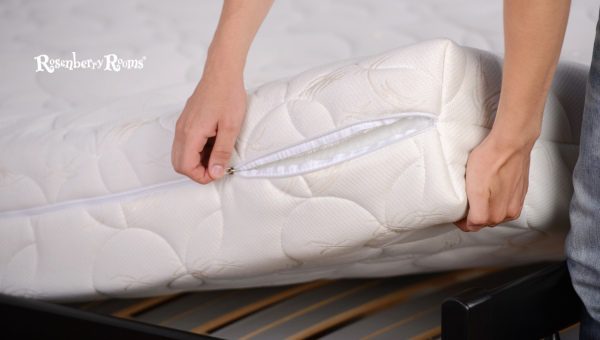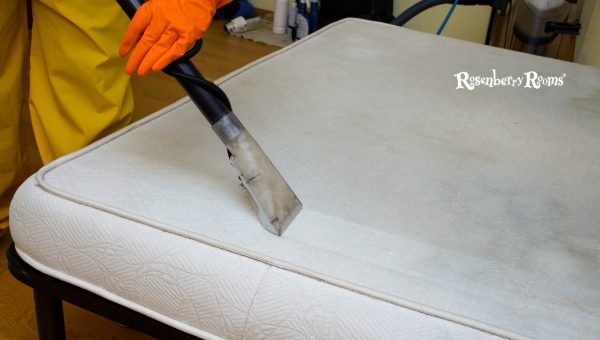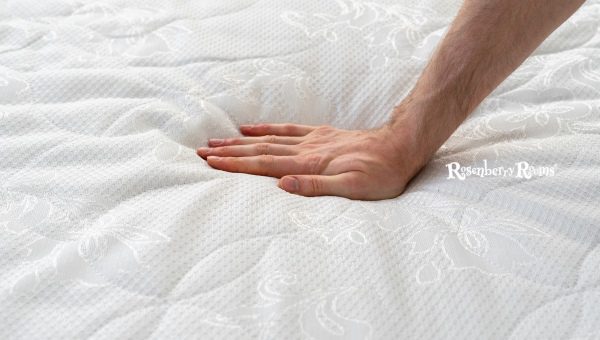Are you getting ready to purchase a bamboo mattress and wondering, "Do bamboo mattresses have fiberglass?"
You're absolutely correct to question this since understanding what our mattresses are made of is crucial for both our health and peace of mind.
Selecting a good mattress can be as impactful as choosing a suitable home. Your bedroom is your sanctuary, and your bed plays a central role in your comfort and rest. After all, you spend roughly one-third of your life sleeping on it.
Ensuring that you're knowledgeable about the materials in your mattress – like whether or not there's fiberglass involved – certainly seems like the smart move to make.
Contents
Bamboo mattresses are specifically designed beds that incorporate bamboo fibers in their construction for either the cover fabric or the internal components.

The use of bamboo provides these mattresses with unique characteristics such as hypoallergenic properties, breathability, and temperature regulation.
They are eco-friendly due to the sustainable growth of bamboo plants and also provide excellent comfort and support.
Bamboo mattresses often come in varieties such as memory foam, latex, or hybrid designs, made even more comfortable by the natural softness of bamboo fibers.
Fiberglass is a highly versatile and durable composite material made from very fine glass fibers. It's known for its strength, affordability, and resistance to heat, chemicals, and impact.
These properties make it ideal for various applications across industries like construction, automotive, aviation, telecommunications, and more.
In terms of structure, fiberglass is created by melting glass and then drawing it through superfine holes to create thin strands or fibers.
These fibers are woven together to form a flexible mesh that can be combined with plastic resin to create strong but lightweight products - this is known as a fiber-reinforced polymer (FRP) or glass-reinforced plastic (GRP).
The inclusion of glass fibers enhances the strength and stiffness of the final product while maintaining its lightweight attribute.
Fiberglass does not conduct heat or electricity and is resistant to fire. Thus, it's often utilized in insulation for homes and commercial buildings as well as electrical casings.
Fiberglass may be used in roofing sheets, doors, and windows due to its corrosion resistance. Car body parts and boat hulls also frequently use fiberglass due to its malleability, which allows complex shapes to be formed.
Its versatility has led it to become one of the most common materials found in daily life despite individuals not necessarily being aware of its presence.
Bamboo mattresses successfully merge comfort, health benefits, and environmental sustainability by incorporating bamboo fibers into their build.

To give you a clearer picture of what you're sleeping on, let's delve into the key components of these mattresses: the bamboo cover, the foam, and the support layer.
The bamboo cover refers to the outer layer that encases all other mattress materials. Most commonly, it's made from either bamboo viscose or rayon, which are incredibly soft and breathable.
Key attributes of these covers include:
Centered right beneath the bamboo cover is usually an additional layer of foam that can be made up of memory foam or latex, depending on your preference.
Noteworthy features of these foams include:
The foundational support layer of bamboo mattresses typically includes coils or a slab of high-density foam.
Highlights of this layer are:
Bamboo mattresses smoothly integrate these materials to offer you an environment-friendly, supportive, and invigorating sleeping surface.
The carefully selected materials extend benefits far beyond mere comfort, underlining why they are growing in popularity among eco-conscious sleepers.
Yes, some bamboo mattresses do contain fiberglass, while many do not. The usage of fiberglass in mattresses is mainly for achieving fire resistance.
Due to potential health risks and usability issues associated with fiberglass, a lot of manufacturers opt not to include it in their bamboo mattresses.
Many prefer using natural, safe fire retardants or barrier cloths like wool or thistle pulp. These substances offer effective fire resistance without the concerns associated with fiberglass.
If you are considering a bamboo mattress and wish to avoid fiberglass, it's recommended that you carefully read the product specifications or contact the manufacturer directly before purchasing. Ensuring high-quality sleep should never compromise your health and safety.
Also Read: Do IKEA Mattresses Have Fiberglass? [Why Does IKEA Avoid It?]
Keeping your bamboo mattress in pristine condition requires a proper cleaning routine. Maintaining its cleanliness extends its lifespan and guarantees you a comfortable, fresh space to rest every night.

Here are easy-to-follow steps on how to clean your trusty bamboo mattress:
First things first, grab your vacuum cleaner. Running it over the surface of your bamboo mattress helps remove dirt particles, dust, dead skin cells, and allergens that can accumulate with regular use.
Use a handheld vacuum or an upholstery attachment with soft bristles for optimal effectiveness. Spend extra time on seams and folds where dust and dirt tend to gather most.
Life is full of surprises, including the occasional spills. To promptly tackle stains on your mattress, you need to spot clean. Prepare a mixture of water and gentle fabric detergent.
Dampen a cloth in the solution and blot the stain gently without rubbing it in - rubbing could spread the stain or cause damage to the material. Be sure not to saturate the mattress; excess water can lead to other problems like mold growth.
Over time, sweat and body oils can make your bamboo mattress smell less than fresh. Sprinkling some baking soda over the entire surface area can work wonders as it absorbs any lingering odors. Let it sit for about 15-20 minutes so that it will do its magic.
After the deodorizing process, vacuum your bamboo mattress again for good measure. This ensures the removal of any residual baking soda and anything else that may have made it home or in your bed during this process.
If moisture is left on your bamboo mattress after cleaning, it becomes an inviting environment for molds, causing potential health risks and damaging your precious sleep haven. Therefore, ensuring optimal drying is crucially important.
To dry properly, ventilate and air dry your mattress, preferably in sunlight, which also has natural disinfectant properties.
In cold or cloudy weather, using a hairdryer is another option, holding it at a safe distance. However, avoid saturating heat on one spot for too long as it may cause damage.
Bamboo mattresses are often considered high quality due to their unique properties and benefits. Firstly, they tend to be more breathable than traditional mattresses thanks to the natural properties of bamboo, which can help regulate temperature and keep you cool during sleep.
The hypoallergenic nature of bamboo fibers also makes these mattresses an excellent choice for those with allergies or sensitive skin.
Many bamboo mattresses feature memory foam or latex layers that conform to your body for personalized comfort and support.
Such composition helps in maintaining proper spinal alignment and relieving pressure points, resulting in a restful night's sleep.
Bamboo is a sustainable resource, making bamboo mattresses an eco-friendly choice. They are generally durable as well, offering longevity that adds value for your money.
As with any product, the quality may vary by brand and model. Therefore, it's important to carefully read product descriptions and reviews before making a purchase decision.
Read More: 15 Best Mattress Without Fiberglass To Buy In 2023
In an ever-evolving world that is swinging back towards nature, bamboo mattresses have risen to prominence for their host of benefits.

Derived from one of nature's most sustainable resources, these mattresses provide not only supreme comfort but also a greener sleep environment.
The perks of using a bamboo mattress extend far beyond its luxurious feel. Here are some key ways that bamboo mattresses contribute positively to your night's rest and the environment.
It's no surprise that more and more Americans are choosing to purchase bamboo mattresses. Advances in manufacturing technology have made it possible to produce high-quality mattresses at affordable prices.
While bamboo mattresses offer several benefits, it is also essential to acknowledge their potential downsides to make an informed buying decision.
One of the most noticeable drawbacks is the high cost. Bamboo mattresses tend to be pricier than other types because of their eco-friendly and hypoallergenic properties. You can expect to shell out a more significant chunk of money upfront for a bamboo mattress.
Like many new products, bamboo mattresses often emit an initial smell commonly referred to as “off-gassing.”
This odor comes from the VOCs (Volatile Organic Compounds) used in the manufacturing process. Although this smell should dissipate within a few days, it can be off-putting.
Bamboo mattresses can be heavier compared to other types because of their dense composition, which might become problematic when you need to move or flip them.
Now, if your bamboo mattress contains fiberglass—which isn't common—here are some potential risks you may encounter:
So, it's worth checking whether this component is present before purchasing. Always make sure to read product descriptions carefully, and don’t hesitate to contact customer service if you need clarification about potentially harmful materials inside your prospective new bed.
Choosing a mattress is a significant decision. It enables you to weigh the pros and cons to make the best choice for your comfort, health, and peace of mind.
Explore More: Does Casper Mattress Have Fiberglass? 2023 [Contain or Not?]
Although some mattress manufacturers may use fiberglass in their products, it is not a common component in most bamboo mattresses.
Fiberglass can be used as a fire retardant in mattresses. However, it's not typically found in bamboo ones.
If your mattress tagging or packaging doesn’t indicate the presence of fiberglass, contact the manufacturer directly for this information.
Direct contact with or inhalation of fiberglass could trigger nose and throat irritation, skin redness, itchiness, and possibly respiratory concerns.
Absolutely – many high-quality mattresses use alternative materials like wool or Kevlar as fire barriers instead of fiberglass.
While bamboo mattresses offer numerous benefits, including breathability, durability, and environmental friendliness, it's essential to understand all the components – especially if fiberglass is involved.
Although not common in bamboo mattresses, the presence of fiberglass could present potential health risks.
It's crucial to do your homework when purchasing a mattress and ensure that you're selecting a product that promotes both comfort and overall health.
Good quality sleep is part of taking care of your well-being. Be diligent in your research to make a decision that you will be happy with for years to come.